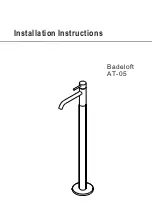
9 Maintenance
9.1 General
CAUTION
Risk of injury on hot surfaces, due to the vacuum or on sharp edges due to improperly per-
formed maintenance work
Improper handling of the pump before maintenance work causes hazardous situations involving a risk
of injury. There is a risk of burning injuries on hot surfaces. There is a risk of injury due to the vacuum
when switching off. There is a risk of cutting injuries due to the access to sharp-edged, rotating parts
when removing the pump.
► Ensure that the pump has come to a complete standstill before performing any work on the
pump.
► Switch off the pump correctly.
► Vent the pump to atmospheric pressure.
► Secure the pump against being switched back on.
► Allow the pump to cool down.
► Seal open connections with the original protective covers immediately after removing the pump.
NOTICE
Damage caused by pointed or sharp-edged tools
Sharp-edged tools damage pump parts during maintenance.
► Never disconnect pump parts such as diaphragm heads using pointed or sharp-edged tools.
► Never use pointed or sharp-edged tools to lift diaphragms.
► If necessary, use a rubber mallet to loosen parts.
9.2 Maintenance intervals
Dismantle the pump only to the extent necessary
Dismantle the pump only to the extent required for maintenance.
Use only genuine parts as listed in the spare parts list.
Valves and diaphragms are wear parts.
Component
Operating hours
Diaphragm
15,000
Valves
15,000
Motor bearing
40,000
Motor capacitors
10,000-40,000
Tbl. 2:
Typical life with normal use
You must check wear parts by the time the achieved pressure values drop off at the latest.
Checking wear parts
1. Clean suction chamber
2. Clean diaphragms
3. Clean valves
4. Check and clean diaphragm heads at regular intervals (depending on the individual case)
5. Inspect diaphragms and valves for cracks.
6. Replace defective parts.
Maintenance
21/40
















































